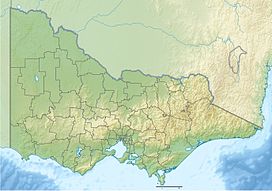Mount Feathertop
| Mount Feathertop | |
|---|---|

Mount Feathertop as seen from the summit track.
|
|
| Highest point | |
| Elevation | 1,922 m (6,306 ft) Australian Height Datum |
| Prominence | 562 m (1,844 ft) |
| Coordinates | 36°53′39″S 147°8′18″E / 36.89417°S 147.13833°ECoordinates: 36°53′39″S 147°8′18″E / 36.89417°S 147.13833°E |
| Geography | |
|
Location in Victoria
|
|
| Location | Alpine National Park, Victoria, Australia |
| Parent range | Victorian Alps, Great Dividing Range |
| Climbing | |
| First ascent | 1853: von Mueller (European) |
| Easiest route | Hike / ski: North Razorback track |
Mount Feathertop is the second-highest mountain in the Australian state of Victoria and is a member of the Australian Alps located entirely within the Alpine National Park. It rises to 1,922 metres (6,306 ft) and is usually covered in snow from June to September. Unlike many other Victorian mountains, Mount Feathertop has steep summit slopes instead of a rounded summit dome.
Mount Feathertop's proximity to the Mount Hotham ski resort has led to it becoming a popular backcountry skiing destination. A sizable snow cornice usually forms along the summit ridge in winter, the collapse of which has claimed the life of a number of people who stood on it. Snow remaining in the summit gullies in spring gives the appearance of feathers - hence the name "Feathertop".
Mount Feathertop was named in 1851 by Jim Brown and Jack Wells, stockmen who worked on Cobungra Station and were the first Europeans to systematically explore the Bogong High Plains.
Dr (later Baron) Ferdinand von Mueller was the first non- aboriginal to climb Mount Feathertop. Unaware that the peak had already been named, he proposed that it might be named Mount La Trobe after Charles La Trobe who was Victoria's lieutenant-governor at the time. Members of the Bright Alpine Club made the first winter ascent in September 1889.
A track from Harrietville was cut in 1906 along a similar route to the current Bungalow Spur track and a rough shelter was built near a spring on a flat area below the treeline. The shelter was replaced by Feathertop Hut in 1912.
In 1925, the Feathertop Bungalow was built, with materials and prefabricated sections transported by packhorse and sled. It had 24 guest beds and provided commercial accommodation on the mountain before being lost in the Black Friday bushfire of 1939.
Forests of Mountain Ash cover the lower slopes of Mount Feathertop up to an altitude of about 1,000 metres (3,300 ft) where Snow Gums begin to dominate. Above the treeline at around 1,700 metres (5,600 ft), vegetation consists of alpine shrubland and grassland.
...
Wikipedia

